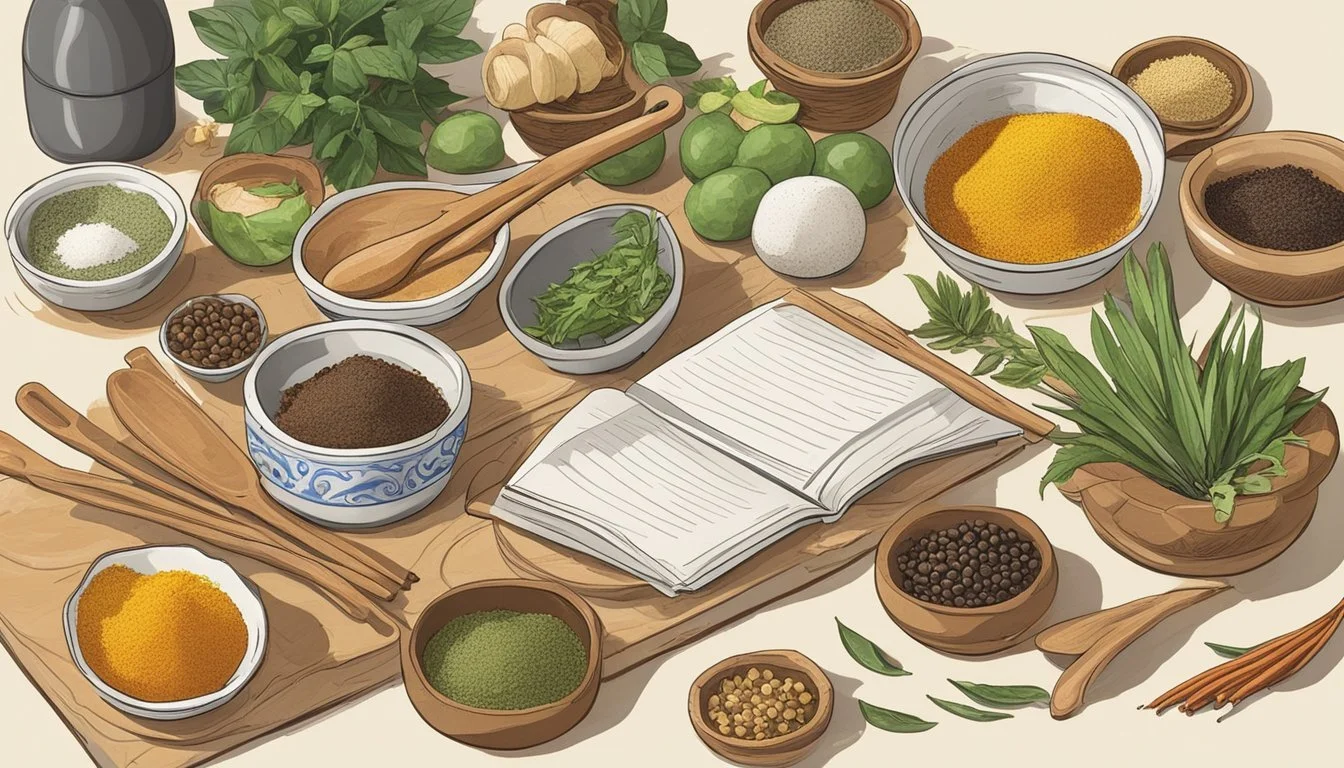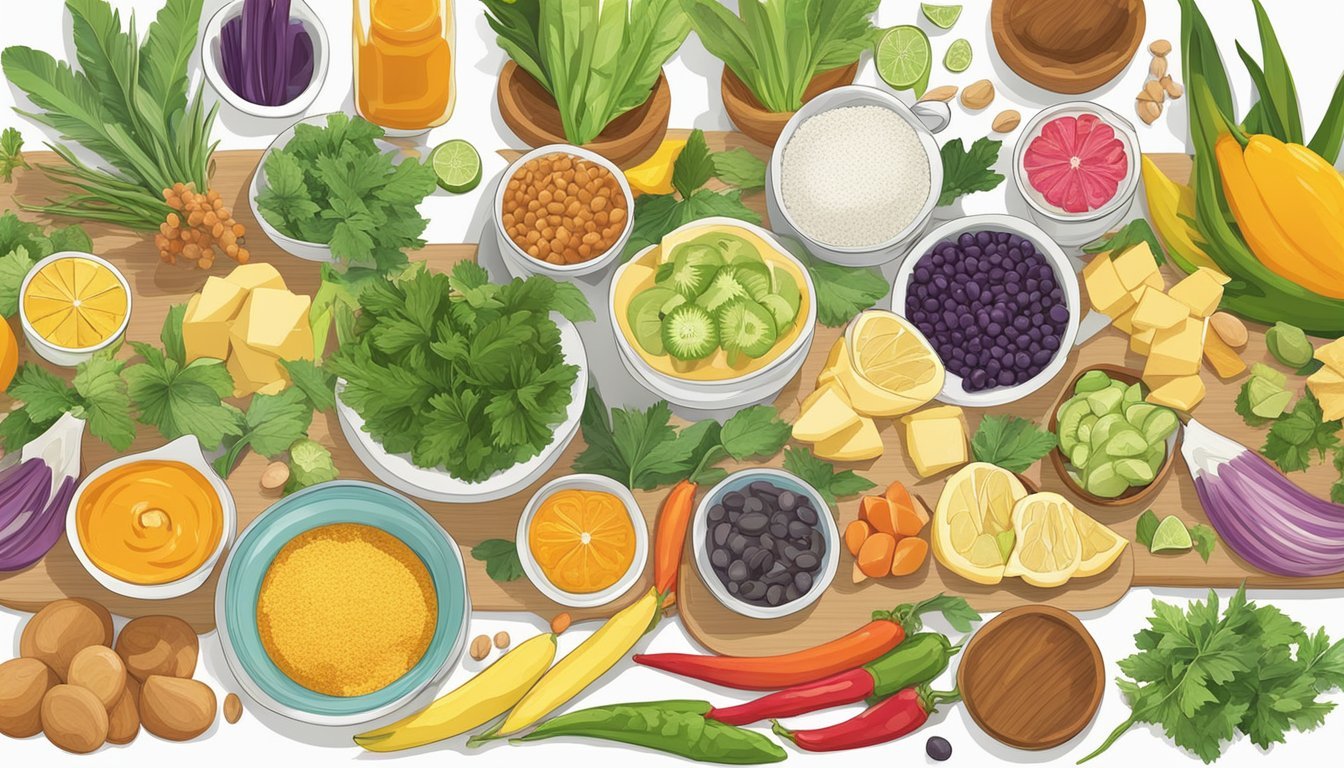How to Cook When You're Trying New Cuisine
Essential Tips for Beginners
Exploring new cuisines can be a culinary adventure that offers a window into different cultures and traditions. When one decides to cook dishes from a cuisine that is unfamiliar, it is not just about following a new recipe; it is about gaining confidence in the kitchen while learning new techniques and ingredient combinations. There is no need for intimidation, as everyone starts from somewhere, and every expert was once a beginner. With the guidance of a trusted cookbook and a willingness to experiment, anyone can begin to prepare dishes outside of their culinary comfort zone.
The process of trying new recipes should be approached with patience and an understanding that it may take several attempts to get a dish right. Cookbooks are invaluable resources that provide detailed instructions, background information on the significance of each dish within its respective culture, and often offer tips on where to source less common ingredients. They serve as both a guide and inspiration for home cooks eager to expand their repertoire.
Cooking a new cuisine reinforces the idea that making mistakes is a natural part of the learning process. Whether it's mastering the balance of flavors specific to a regional dish or getting accustomed to cooking techniques like stir-frying or braising, each experience adds to one's culinary skill set. It is with practice and persistence that cooking unfamiliar dishes can become second nature and lead to more successful and satisfying meals in the future.
Getting Started with New Cuisines
When approaching a new cuisine, chefs need to focus on gathering the right tools, understanding the foundational elements that define the cuisine, and maintaining realistic expectations about the learning curve involved.
Kitchen Essentials
For beginners, a kitchen stocked with essential tools is crucial when experimenting with new cuisines. They should equip their workspace with:
Knives: A sharp chef's knife and a paring knife for precision cutting.
Cutting Board: A sturdy board for safe chopping.
Pots and Pans: A variety of sizes to accommodate different recipes.
Measuring Cups and Spoons: For accurate ingredient portions.
Understanding the Basics of the Cuisine
Chefs need to familiarize themselves with key components that form the backbone of a new cuisine. They should:
Research common spices and herbs unique to the cuisine.
Learn about staple ingredients like grains, legumes, or proteins.
Understand typical cooking methods such as steaming, frying, or roasting.
Setting Realistic Expectations
Absolute beginners should understand that mastery takes time. They must:
Start with simple recipes to build confidence.
Be prepared for some trial and error.
Recognize that developing skills in cooking new cuisine is a progressive journey.
Exploring New Recipes
When venturing into a new cuisine, the key to success lies in selecting trustworthy recipes and applying them with practical techniques. A methodical approach can ensure a smoother cooking experience and delicious results.
Finding Reliable Recipes
To discover new recipes for a desired dish, food enthusiasts should prioritize recipe sources known for credibility. They have a few options:
Cookbooks: Authored by experienced chefs or cultural ambassadors, cookbooks often provide well-tested recipes.
Online Food Platforms: Websites such as Epicurious offer a vast collection of recipes with user ratings.
Food Apps: A recipe app can provide convenience with searchable databases and user reviews to gauge reliability.
When selecting a recipe, one should look for:
Clear instructions
Listed cooking times
Indications of serving size
Nutritional information
User comments or ratings
Recipe Application Tips
Once a reliable recipe is obtained, applying the following tips can enhance the cooking process:
Ingredient Readiness: Gather all ingredients and prepare them according to the recipe before starting to cook.
Technique Research: For unfamiliar techniques, watching tutorial videos can help a home cook master the necessary skills.
Taste Adjustment: Recipes can be a guide, but one's taste preferences should dictate final seasoning adjustments.
Remember, the success of preparing a new recipe often depends on a cook's ability to adapt and improvise with confidence and clarity.
Preparatory Research
When venturing into the realm of new cuisine, thorough research lays the groundwork for a successful cooking experience. This preparatory phase is crucial for understanding the culinary traditions, identifying key ingredients, and ensuring the availability of authentic elements.
Cultural Significance
The culinary practices of a region are deeply interwoven with its historical and cultural tapestry. One should not only research recipes but also understand the significance of dishes within a culture. This might involve learning about traditional cooking methods, typical mealtime customs, or the role certain foods play in local festivals and celebrations. By appreciating these nuances, individuals can approach new cuisine with respect and authenticity.
Ingredient Familiarization
New cuisine often incorporates a unique set of produce, spices, and fresh herbs (how long do fresh herbs last?) that might be unfamiliar. It's essential to familiarize oneself with these components:
Produce: Study the appearance, taste, and texture of fruits and vegetables specific to the cuisine.
Spices: Take note of the spices commonly used, their flavor profiles, and how they are blended or used in cooking.
Fresh Herbs: Understand the significance of herbs in the cuisine, including which ones are used fresh or dried.
A good starting point is to review a list of staple ingredients that the cuisine relies on and the typical preparation methods for each.
Sourcing Authentic Ingredients
Locating authentic ingredients may require some effort. One might need to:
Visit specialty or international grocery stores.
Check online retailers that specialize in regional ingredients.
In some cases, travel may even be involved to acquire the freshest, most traditional products.
Identify the key ingredients that cannot be substituted and make a priority to source those accurately. Here are examples of commonly sought-after items in various cuisines:
Cuisine Key Ingredients Italian Olive oil, Parmesan cheese Thai Lemongrass, Galangal, Fish sauce Mexican Corn, Chillies, Cilantro
By diligently researching and respecting the cultural significance, familiarizing oneself with essential ingredients, and sourcing them appropriately, one sets a strong foundation for cooking and experiencing new cuisine with authenticity and confidence.
Mastering Key Techniques
When one dives into new cuisines, understanding and mastering certain cooking techniques is essential. These techniques often bridge the gap between familiar cooking methods and the authentic preparation of new dishes.
Cooking Fundamentals
The foundation of cooking across different cuisines starts with mastering the basics. Key skills, such as how to properly heat olive oil in a pan without reaching its smoke point, are fundamental. One should also be familiar with the maintenance and usage of cast iron cookware, which is versatile across various culinary traditions. Here is a brief list of basic cooking fundamentals:
Heat Management: Controlling the temperature when cooking, especially with olive oil, ensures flavors are not compromised.
Proper Tool Usage: Utilizing cast iron pans and other cookware correctly can greatly influence the cooking process and outcome.
Basic Cooking Methods: Techniques such as steaming, boiling, sautéing, and baking are universal and should be honed.
Adapting Techniques to New Dishes
Applying these fundamental skills to a new cuisine involves adaptation and practice. For example, stir-frying in a cast iron skillet may require adjusting heat levels as compared to a traditional wok. Here's a short breakdown of adapting techniques to new dishes:
Ingredient Preparation: Learning to prepare ingredients as required by the new cuisine, be it chopping styles or marinating processes.
Technique Adjustment: Adapting frying, marinating, and cooking times to suit new recipes while considering different cooking surfaces like cast iron.
Sensory Adaptation: Developing one's sensory skills to understand the nuances of flavor and texture in new cuisines, thereby applying techniques more effectively.
Ingredient Exploration
When venturing into new cuisines, the key to success lies in a willingness to experiment with unique ingredients, learning to balance various vegetable and protein alternatives, and mastering the art of seasoning to truly capture the essence of the cuisine.
Trying Unfamiliar Ingredients
Cooking with unfamiliar ingredients can be both exciting and daunting. Chefs recommend starting with a staple such as rice, which is versatile and present in many cuisines. Asian dishes, for instance, often incorporate noodles or rice along with regional vegetables not common in Western cooking. Gradually incorporate these new items into your diet to develop an appreciation for their textures and flavors.
Example:
Sesame seeds—try adding them to salad dressings for an Asian twist.
Vegetable and Protein Variations
Exploring different vegetables and proteins lays the foundation for authentic cuisine. If your recipe calls for a familiar base like potatoes, consider swapping it for local variants or vegetables commonly used in the cuisine you're exploring. For protein, a classic like chicken teriyaki is an excellent entry point into Japanese cooking.
Variations Table:
Standard Ingredient Alternative Cuisine Potatoes Lotus root, Taros Asian Beef Duck, Tofu Chinese Fish Other seafood like squid or octopus Mediterranean
Seasoning and Flavoring
The correct use of seasonings and flavorings is crucial for authenticity. Whether it's the bold simplicity of garlic and olive oil in Mediterranean dishes or the complex blend of spices in Indian curries, understanding the balance of flavors is key. Beginners should experiment with spices by adding them one at a time to a familiar base like pasta, observing the changes in flavor profile.
Flavor Enhancement:
Begin with a simple recipe like garlic noodles and progressively introduce additional spices such as star anise or cinnamon sticks to understand their impact.
The Art of Experimentation
Experimentation in cooking is a methodical venture, embracing variety and cultivating an open-minded approach to discovering new recipes. It's about merging tradition with innovation to create something unique and satisfying.
Balancing Flavors
One begins by understanding the flavor principles. Each cuisine has its set of foundational flavors that harmonize the overall taste of a dish. For instance, when exploring Asian cuisine, a chef might combine soy sauce (salty) with lime juice (sour) and chilies (spicy) to achieve a balanced flavor profile. They should keep these combinations in check:
Salty: Soy sauce, fish sauce
Sour: Vinegar, citrus juices
Sweet: Sugar, honey
Bitter: Bitter greens, unsweetened cocoa
Umami: Mushrooms, aged cheeses (What wine goes well with aged cheeses?)
Combining Textures
The juxtaposition of textures adds depth and interest to a dish. A crispy element might sit alongside something creamy, like a crunchy topping on a smooth soup. When venturing into new cuisines, it is vital to consider how textures interact and complement each other. Here are some textural contrasts to consider:
Smooth Crunchy Creamy Chewy Pureed soups Toasted nuts Risottos Grilled meats Mashed vegetables Croutons Cheese-based sauces Cooked legumes
Through the disciplined practice of experimentation, one can navigate the vast oceans of culinary variety with confidence and curiosity, continuously enhancing their skill in the kitchen.
Accommodating Dietary Preferences
When one experiments with new cuisines, understanding and incorporating various dietary preferences is crucial. Vegetarian options, in particular, require special attention to ensure inclusivity and nutritional adequacy.
Navigating Vegetarian Options
For those who follow a vegetarian diet, it's important to look for plant-based ingredients that can provide a satisfying alternative to meat. When cooking new foods from different cuisines, chefs should identify key ingredients that align with vegetarian needs while maintaining the authenticity of the dish.
Key Considerations for Vegetarian Cooking:
Protein Sources: Utilize high-protein ingredients like beans, lentils, tofu, and tempeh to replace meat.
Flavor: Ensure that the depth of flavor is preserved by using rich stocks, herbs, and spices.
Nutritional Balance: Include a variety of vegetables, grains, and nuts to cover the nutritional spectrum.
Examples of Vegetarian Swaps in Various Cuisines:
Cuisine Traditional Ingredient Vegetarian Alternative Italian Meatballs Lentil or chickpea balls Mexican Carnitas Jackfruit or mushroom Indian Chicken Curry Chickpea or vegetable curry Thai Fish Sauce Soy sauce or vegan fish sauce
By remaining meticulous about ingredient selection and cooking techniques, chefs can create vegetarian versions of international dishes without compromising on taste and satisfaction.
Shopping and Storing Techniques
When approaching a new cuisine, knowing how to shop efficiently and store ingredients properly is crucial to maintain the integrity of the flavors and freshness of the ingredients involved.
Efficient Grocery Shopping
They should first create a detailed shopping list to avoid multiple trips to the grocery store. This list should prioritize:
Produce: Fresh and specific to the cuisine.
Spices: Fundamental to the dish's authenticity.
Fresh herbs: Often central to the flavor profile.
One should always look for:
Seasonal produce: For the best quality and price.
Ethnic markets: They can offer a more authentic selection specific to the cuisine.
Consider buying spices in small quantities to ensure they don't lose their potency before use. Store pantry items in airtight containers to keep them dry and preserve their flavors.
Preserving Freshness
For produce, one must understand the optimal storage methods to maximize freshness:
Leafy greens: Store in the fridge, wrapped in paper towels for absorbency.
Root vegetables: Keep in a cool, dark place like a pantry.
Tomatoes: Leave on the counter away from sunlight to avoid mealy texture.
Fresh herbs are best stored:
In the refrigerator, with stems in water like flowers or
Wrapped in a damp paper towel and placed in a resealable bag.
Use or freeze leftovers within a couple of days to minimize waste and maintain quality. If they plan to use certain ingredients frequently, it's sensible to store them in easily accessible areas of the kitchen.
Serving and Presentation
When presenting a dish from a new cuisine, it's essential to respect the cultural origins while also putting a personal touch on the presentation. The plating of the food is a chance to showcase creativity and attention to detail. One should consider using contrasting colors to make the dish visually appealing and highlight the freshness of the ingredients.
Plating Techniques:
Height: Creating height on the plate can add an element of sophistication.
Textures: Incorporating a variety of textures entices companions with intriguing and inviting visuals.
Portion: Serve smaller portions to highlight the dish’s components and avoid overcrowding the plate.
Garnishing Tips:
Use edible garnishes that complement the dish in flavor and color.
Avoid over-garnishing, which can detract from the main elements of the dish.
Plate Selection:
Choose the right plate to enhance the presentation; the size and color should complement the food, not overpower it.
Ensure the plate is clean with no fingerprints or smudges before serving.
When one presents food from a new cuisine, they should aim to convey the dish's story. It should invite companions to not only enjoy the meal but also appreciate the culinary journey. Serving with confidence and ensuring each element on the plate has a purpose will contribute to a successful and enjoyable experience.
Reflection and Continual Learning
When one engages in the culinary exploration of new cuisines—such as those from Asia—it's imperative they reflect on their experiences and commit to ongoing learning to enhance their proficiency and enjoyment.
Reviewing the Culinary Experience
After trying a new food or recipe, it's beneficial for the cook to take a moment to reflect on the process and the outcome. They should ask themselves specific questions:
Was the flavor profile of the dish well-balanced?
A dish may require adjustments in seasoning to suit personal tastes or to align more closely with the traditional flavor of the cuisine.
How did the dish compare to authentic examples of the cuisine?
Especially when learning to cook Asian cuisines known for complex flavors, such as the balance of sweet, salty, sour, and bitter, it can be helpful to compare one's dish to those prepared by experienced chefs or to recipes established within the culture.
This practice encourages the cook to step out of their comfort zone and consider adjustments for future attempts.
Expanding Your Culinary Repertoire
Once a cook has reflected on their culinary experience, they can look to expand their repertoire. This process can be broken down into a few actionable steps:
Experiment with new ingredients:
Start by incorporating one or two unfamiliar ingredients into familiar dishes to explore their flavor profiles without overwhelming the palate.
Integrate new cooking techniques:
If frying and sautéeing are comfortable techniques, they might consider steaming or slow simmering next, which are often used in Asian cuisines.
By continually introducing new elements and techniques, the cook naturally broadens their skills and familiarity with the cuisine, gradually building a more comprehensive ability to prepare dishes from regions such as Asia.
Conclusion
Embarking on a culinary adventure requires a mix of curiosity and confidence. When trying new cuisine, one's mindset plays a significant role in the overall experience. The key is to approach cooking with an open mind, acknowledging that it's a learning process.
Confidence is built over time through practice and patience. It's vital for individuals to give themselves the grace to make mistakes and learn from them. Here are some concise tips to keep in mind:
Enjoy the process: Cooking is as much about the journey as it is about the end result.
Embrace learning: Each mistake is an opportunity to improve skills and understanding.
Share the experience: Cooking for others can provide feedback and encouragement.
Reflect on progress: Take note of how skills have developed over time.
Remember, confidence in cooking comes from repeated trials and perseverance. Whether one is mastering the perfect bake or experimenting with exotic spices, the goal is to grow and enjoy the flavors of the world.











